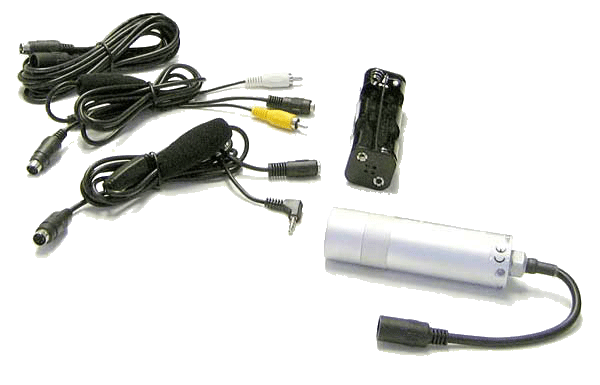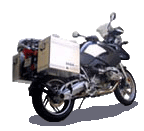
 Let's see that instant replay...
Let's see that instant replay...
Why did I buy a helmet cam? Well, there are several reasons:
- Insurance (just in case of an accident)
- To catch people doing stupid things and post it on the web site
- To capture friends riding with me on long trips for those
unforgettable memories
The primary reason, insurance. However, it turning out to be
anything but just plain 'O insurance. In fact, it's quite the
conversation piece. Some people are scared of it, some people are
curious about it, and others just really don't care. For the most
part, people are curious and want to know why. I've had
everything from a guy in a Beemer ask me what it's for to a whole
family in an SUV say, "What's up with that?" In general people
are very nice and say: "Hello.What is that for?"
Even the Security Officers at work are curious about the camera.
Friends that ride think it's a great idea and good insurance.
Mind you, I shouldn't receive credit for this idea. In fact, it
came from a amateur
motorcycle racer that appeared on the L.A. evening news that gave me
the
idea. She got into an accident on the I15 freeway. The car
driver that caused the accident even tried to blame her for the entire
thing. It was caught on tape so the guy had to pay for this
lies. I saw the results of that accident and thought the
driver was very smart to have a helmet cam. So I thought I would
follow suit.
In fact, just a couple of days
after clicking the submit button to purchase the cam, I wish I already
had the
camera mounted and recording because I was seeing drivers do some
really
stupid driving on the road. A driver of an old suburban decided
that traffic was going too slow for him so he needed to pass 5 cars,
all in a row, on the right side of traffic, where there is no second
lanes on our side of the street, to get ahead of everybody else.
It's not like cars would pop their front end on the side streets when
they encounter a blind corner. Drivers would never do such
a thing. Nah, that's not possible. Sarcasm aside, that
driver was an idiot. Something else I forgot to mention, we were
all moving at about 30-35MPH when this guy decided he was the tarmac
god and owned every street in town. How rude.
But now that I have a helmet camera mounted, it's funny how people's
behavior change around me. I haven't seen one instance of stupid
driving yet. I'm sure it
will happen one of these days. Personally,
not seeing anything is a preferred choice for me. I like boring
uneventful rides. You have to remember
one thing, I ride sane (e.g. max 5 MPH over the speed limit). If
cars want to pass me, they're more than welcome. If cars want to
drag race with me, they can win every time if they like. As
mentioned in other articles, I drive like an old man and I'm proud of
it. It suits my purpose to survive and ride every day for the
rest of my life.
Anyway, here's what it took to do what I wanted. I wanted the H2O
camera because I do silly things like ride in a monsoon. From
I purchased the Viosport
Adventure Cam H2O Essential Package. Motorcycle Superstore is
awesome! It's my favorite motorcycle Internet store now.
Sometimes they're not the fastest but they have killer
prices. I'm not in a hurry the majority of the time so I don't
mind waiting, if there is a wait to be had. The contents of the
package looks something like this:
The camera is a lip stick cam but the water tight housing makes the
camera a lot bigger than it really is. Just think, I can dunk my
camera over 150ft deep and it will be fine. Uh yeah...
There is also a zip-tie mounting kit that comes with it but it's no
good for helmets. You think that the folks that put this thing
together would think that a helmet is normally round in shape, not flat
like a pancake. Oh well.
My favored choice of mounting material? You guessed it ...
Velcro! This camera is going nowhere! Plus it's a lot
lighter than putting any metal or plastic on the helmet. Here's
how it goes.
As you can see, it's very obvious this is a helmet cam. Being
this blatant about the camera can only do one thing for you, pick up
chicks! Uh... NO. It just makes people curious as to "What
in the world is this humongous appendage doing hanging on this guy's
head? What could he possibly want to do with it?" Hence
people will roll down their windows to ask, "What's that for?"
Trust me, it happens, and definitely more than quintuple times.
Anyway, here's a close up view. I decided to run the cables on
the outside of the helmet because I prefer it not be a permanent
installation. This allows me to remove the camera when I'm ready
for my replacement helmet, which is coming within the month. Yes,
another Arai XD. White this time. Is it because I want to
look like a COP? I don't think so. I like white because I
think it's cooler during the summer months. Plus it's easier on
the wallet to not have the fancy smansy patterns. The patterns
don't really do much for me anyway.
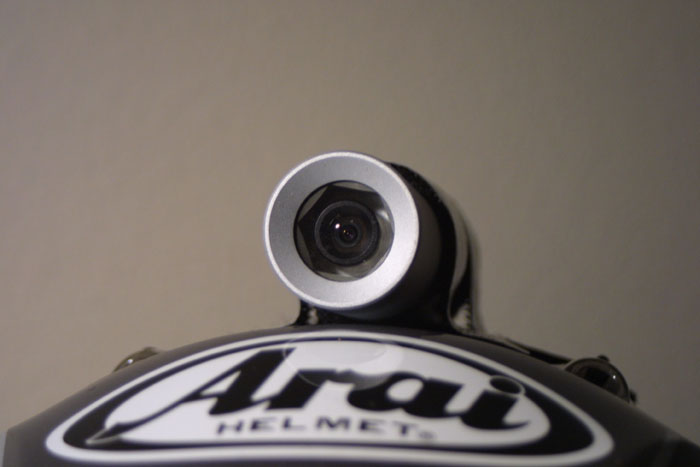
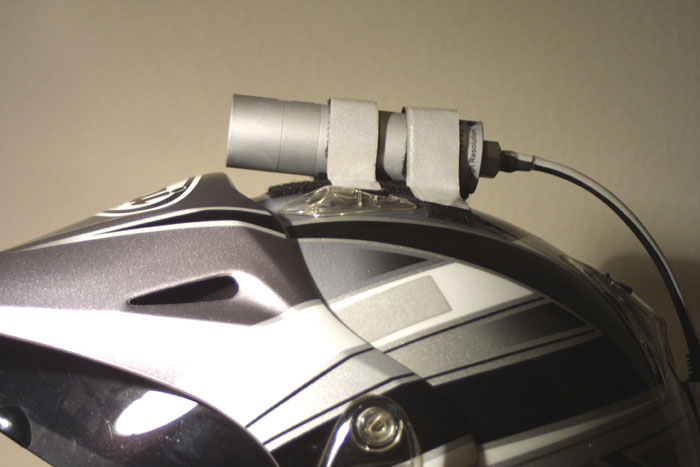
This is actually a good angle. You'll see this when you look at
the snaps of
the camcorder's preview screen.
The white-silvery stuff is actually 3M reflective tape put on the
camera's input cable and Velcro strips. I figured the reflective
qualities of the reflective tape will help preserve the camera input
cable from being dried out from the sun. Plus it makes the helmet
more visible at night.
The entire camera and camcorder system runs on batteries. The
camera has it's own 12V battery pack and the camcorder has it's own
rechargeable battery. I could hook up the camera to the bike's
electrical system, but I don't care to do that at this time.
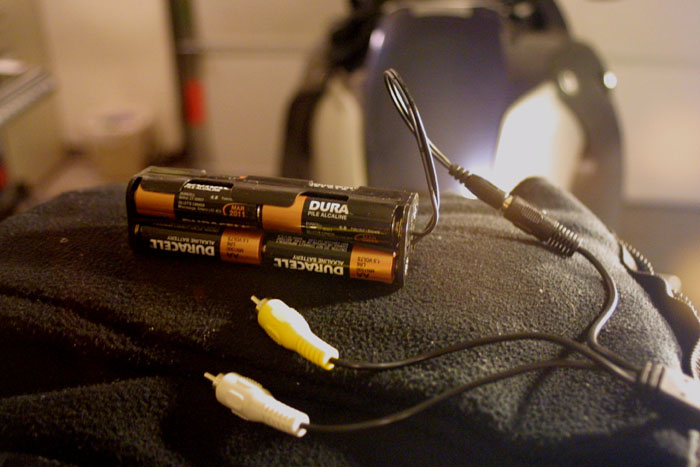
8AA x 1.5V/AA = 12V
The video cable is yellow and the mono audio cable is white.
The cable for the helmet cam is routed from the Marsee Bravarian bag
under the driver seat to the front of the driver seat where the Baehr
intercom connector is located. I didn't do anything with the
video cable except for looping it around the rubber tie down for the
tool bag under the driver's seat.
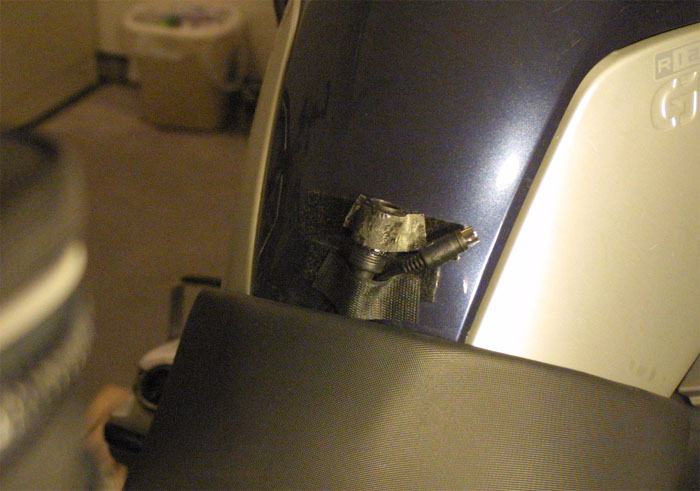
The video cable is the small connector to the right of the intercom
connector.
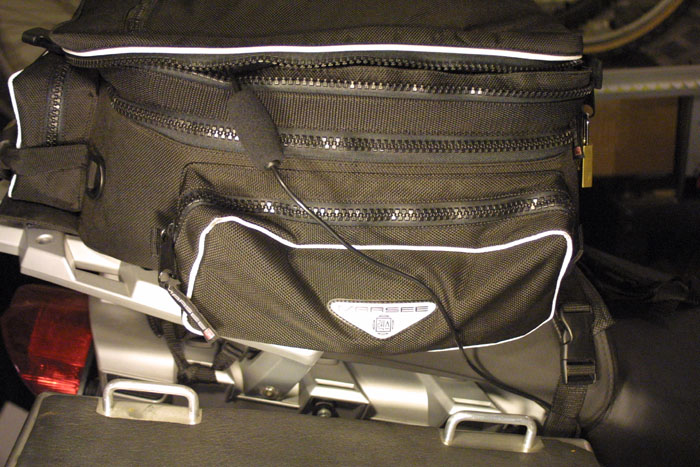
Under the seat, up the side, and into the Marsee bag.
You can see the microphone at the top of the Marsee bag.
I have an old Hi-8 digital camera that I use to record all the
action. Because it's digital, a 120 minute Hi-8 will only last 60
minutes. This is a serious limitation but oh well, I guess I just
have to bring a lot of video tapes to record long trips.
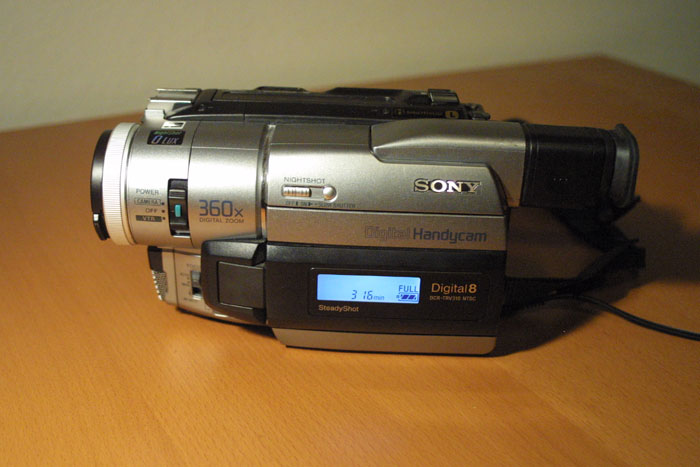

Set the camera in VTR mode with the video, audio, and power pack
connected
for the helmet cam and I'm ready to record.
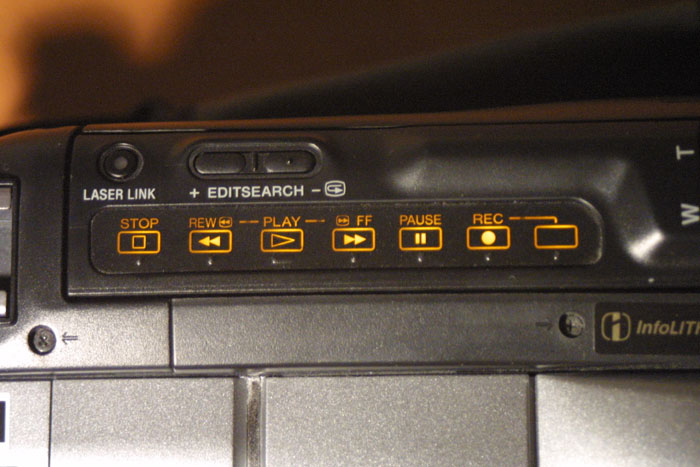
I just press the two REC buttons at the same time on the right and I'm
set to go.
And here are some snapshots of the camcorder preview screen. I
don't have a means to capture the video on my computer so this is the
best that I can do. For those that think I can get a better and
smaller camcorder, you're right. However, since I already have
this camcorder, I don't want to run out and spend another $1K for a
camcorder. I'll use this one until it chokes. Then I'll
worry about getting a new camcorder. For my purposes, the big
heavy old camcorder does a perfectly fine job for the commute.
For those that are interested in doing the same thing, you can purchase
this helmet cam for approximately $350. You can click on the link
at the top of the article to find out the real pricing and
details. If you're wondering about the weight of the camera, it's
196g. When I first used it, I noticed the minor weight
difference. After two weeks of riding, what camera?
Installation difficulty? I give it a 3 in difficulty (e.g. I
think my kids could have done it). Well, maybe not my 5/6 year
olds but definitely it's easy to put together.
Helmet Cam
Update [July 18, 2006]
I've been riding 5 days a week for 1 1/2 weeks and the batteries
finally gave out. That's an average of 1 hour per day use.
That come to a total of 7 hours for one pack of batteries (e.g. 8
AA). That's fair usage. However, I can see myself going
through batteries like drinking Coke if I keep on using the camera in
this manner. It's probably a good idea to either get rechargeable
batteries or tie the camera's power directly to the bike. Yet
another thing to tie into the accessory power plug.
Update
[Monday - August 6, 2007]
It's not my suit, my motorcycle, my helmet, my goggles, nor my so
called electro statically charged personality that attracts
attention. No sir. It's the helmet cam. It's like a
big sugar cube set aside for the honey bees to swarm from miles
around. Most people look and are curious about it. Just
today while I was riding home from work, I was confronted by a rider on
an R12GS. As I stop at a stop sign, he pulls up to me to say
hi. My first comment to him was, "Nice bike. I use to own
one of those." I thought it was a new fangled '06 or '07 R12GS
but it turned out to be an '05, what I use to have. I started to
say a couple more things until the car behind us honked. I
scooted and continued on my journey home until the guy caught up to me
again and asked me to pull over for a quick conversation. Sure, I
pulled over and we chatted a bit. Ultimately the question comes
out, "What is the camera for?" I told him it was for insurance
and for vacation footage. Even before this, a fellow worker at
work noticed the camera and asked me what it was for. I told him
the same thing before heading for home. Too funny.
I had purchased the upgraded helmet cam from VioSport (e.g. the
Adventure Cam 3) and was planning on changing out the existing
Adventure Cam 2. However, the Cam 2 is so much bigger that its
easily noticeable. This is a plus as people take notice and
wonder. The size coupled with the thought of having to re-wire
everything for the Cam 3 made the swap all that much more
unattractive. As a result, I'm going to mount the Cam 3 as a rear
facing camera. I've attempted this with a cheapy Oregon
Scientific camera before and it was cool to record what is happening
behind me. What's even better is I can easily tell who is
tailgating me because their license plate is nice and big on
tape. You can think I'm paranoid. That's fine but it's also
way cool to video tape my friends on a trip riding behind me. Now
all I need is a camera on the left and right and all angles are
covered. Just kidding. Trust me, the logistics of worrying
about one camera is bad enough already. Having two camera is
already much more complicated as it. 4 cameras is insane.
That is unless you're trying to produce your own IMax motorcycle
movie. What's the most problematic aspect of video taping?
Battery life and carrying enough media for whatever trips you're going
on. After a while the number of tapes and extra batteries pile up
really fast.
Written on: July 17, 2006
Last modified: August 6, 2007




